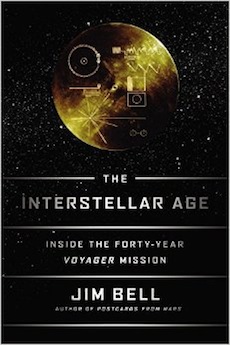By Jay M. Pasachoff
The word that comes to mind is “inspiration.” Planetary astronomer Jim Bell tells the personal story of how he was inspired by the march through the outer solar system of the twin Voyager spacecraft launched by NASA in 1977.
My other main thought in reading the book was: What a lucky guy! Jim Bell was an undergraduate and lucked into helping a professor just as the Voyager mission was getting under way. “Clerical error” is how he and his friends often thought of themselves for the reasons for which they got into Caltech or into the Jet Propulsion Laboratory room where images were being radioed back from Uranus.
In Bell’s very readable book, we learn about personal stories and personalities involved in the space program and its popularization to the general public, with heroes like Ed Stone, Project Scientist on the mission now for over 50 years, and the late Carl Sagan, whose work has been taken up by Neil deGrasse Tyson on TV (and Twitter) and by Bill Nye, the Science Guy, at the Planetary Society.
The twin Voyagers were launched in 1977, with stabilized spacecraft that could send back real, steady images, improving on the scans sent back by NASA’s rotating Pioneers a few years earlier. Voyagers 1 and 2 reached Saturn in 1980 and 1981, respectively. NASA’s Galileo in 1995 and Cassini in 2000-2001 improved on Voyager’s imaging of Jupiter just as Cassini has done since 2004 and still does as it orbits Saturn. But the Voyagers kept going, and with their plutonium power-supply able to last for perhaps 50 years, are going—or maybe in one case—have gone out of the solar system.
Voyager 2 was sent, with a power boost and a directional change from Saturn’s gravity, to Uranus in 1986—with the public release of best images put off by the Challenger disaster—and then to Neptune in 1989. Our unique close-up views of those worlds gave thrills to all who saw them. This summer, we anticipate such revelatory images to come from NASA’s New Horizons spacecraft’s flyby of dwarf-planet Pluto—and who knows if such a mission would have been funded if Pluto had not been considered one of the ordinary planets at the time that the mission was improved.
We learn from Bell (Chapter 3: Message in a Bottle) about the story behind the Golden Record (actually, gold-anodized copper) that the Voyagers carry—and I am proud to have been the photographer of one of the 116 images that are on that record along with samples of music, other sounds, and greetings from around the world.
This review is too short to do justice to Bell’s descriptions of the excitement as the Voyagers passed Saturn and then Voyager 2 on to Uranus and Neptune. He tells us conversationally about the science as it was discovered, and then brings in discoveries since from other spacecraft, including the thousands of exoplanets being discovered from NASA’s Kepler spacecraft. We read his thoughts about the future, too; I don’t remember ever reading anything comparable to a “plan to turn the cameras back on in the year 298,015.”
Let’s hope for a new generation of scientists to be inspired by Jim Bell’s book, by space successes of 2015 for NASA’s Dawn spacecraft at asteroid Ceres and for New Horizons at Pluto, and then for the August 21, 2017, solar eclipse whose path of totality will cross the continental United States from Oregon in the northwest through South Carolina in the southeast, with partial phases visible from anywhere in the country.
Astronomer and author Jay M. Pasachoff is the director of Hopkins Observatory and Field Memorial Professor of Astronomy at Williams College. He is a Visitor in the Planetary Sciences Department of Caltech. Williams College is home to the Gamma of Massachusetts Chapter of Phi Beta Kappa.




